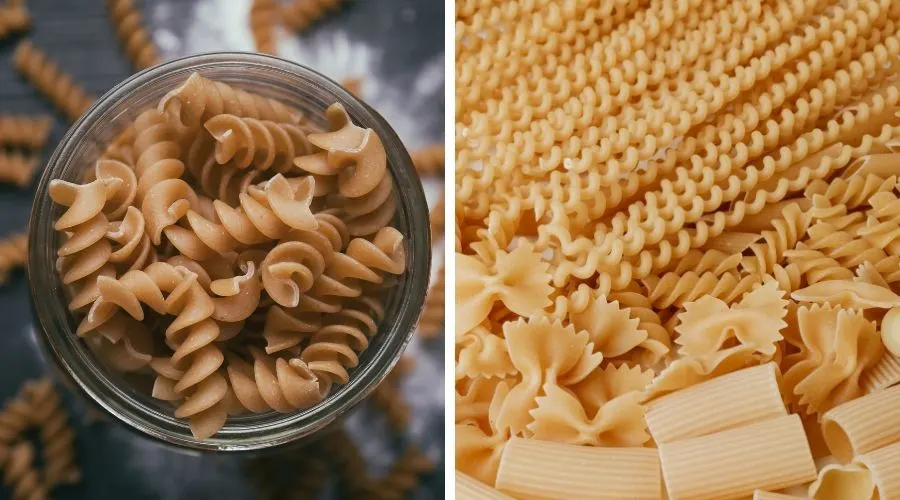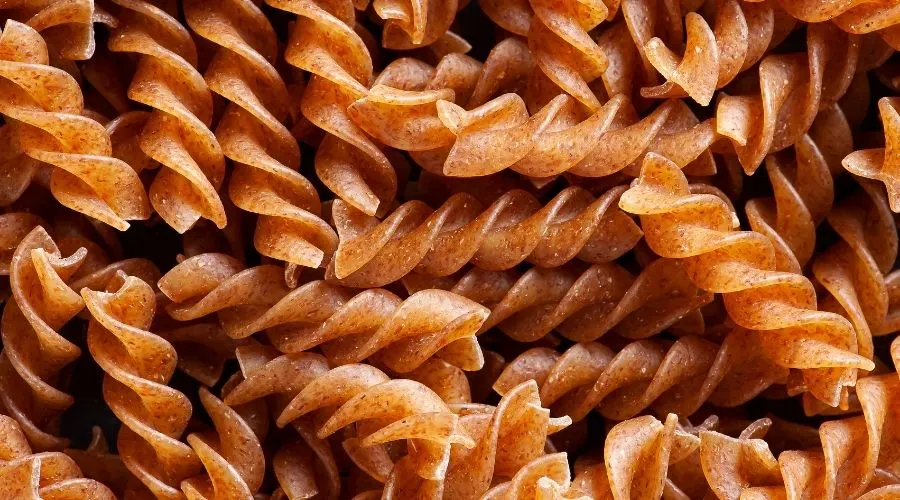We’re all told that whole grain (or wholemeal) food products are better for us, but is this really the case when it comes to pasta?
I wanted to find out the real difference between the two kinds of pasta, so in this article, I’ll be comparing brown (wholemeal) pasta head-to-head against white pasta to find out which is best.
Find out the difference between the two when you compare ingredients, nutrition and flavor – also, we’ll be asking you which one you like best.
Also in This Article
In a hurry or looking for something specific? Use the links below to jump to the relevant section:
- Ingredients Comparison
- Brown Pasta Vs. White Nutritional Comparison:
- Best for Calorie Content
- Best for Carbs & Sugar Content
- Best for Protein Content
- Best for Fat Content
- Best for Fiber Content
- Best for Sodium/Salt Content
- Best for Vitamins/Minerals
- Best for Flavor/Texture
- Best for Price
- Overall Winner
Brown Pasta Vs. White Pasta – Compared
The main difference between white and brown pasta is the flour used to make it. White pasta is made with white refined flour, and brown pasta is made with whole-grain flour, which contains, as the name suggests, ‘the whole grain.’
With white pasta flour (usually Durum flour), the husk part of the grain is removed to produce a smooth, refined flour, and when this flour is used to make pasta, it creates a light-colored, more delicate product.
Whole grain pasta has a distinctive brown color which comes from whole grain flour, this produces a nuttier and more robust flavor, and it’s suggested that brown pasta is the heather option compared to white pasta.
Ingredients Comparision
Below are the typical ingredients used to make brown and white pasta (I used Barilla for this comparison).
As you can see, wholegrain pasta contains one simple ingredient, whole grain durum wheat flour, whereas the white version also contains semolina and is fortified with added vitamins and minerals.
Although not all pasta is fortified, this is typical of products that use white flour (including bread), where the manufacturer adds extra nutrients to a product that has little nutritional value. In contrast, whole grain products have naturally occurring nutrients meaning they don’t need to be fortified.
Please note that these are typical ingredients that may vary between brands.
| Brown Pasta Ingredients | White Pasta Ingredients |
| Whole Grain Durum Wheat Flour | Semolina (Wheat), Durum Wheat Flour, Vitamins/Minerals: Vitamin B3 (Niacin), Iron (Ferrous Sulfate), Vitamin B1 (Thiamine Mononitrate), Vitamin B2 (Riboflavin), Folic Acid |

Brown Vs. White Pasta Nutritional Comparison
In the following sections, I’ll go through the differences between whole-grain and white pasta for each nutritional category, and the winner will be revealed at the end!
I’ve compared like-for-like pasta shapes to keep things as accurate as possible, and I’ve used the same brand (Barilla) for consistency. All figures are based on averages and are applicable to dry (uncooked) pasta weights.
Best for Calorie Content
Whole-grain pasta contains fewer calories than white pasta per weight based on average calorie values.
The chart below shows the average number of calories per 100g/3.5oz of pasta (dry weight); as you can see, whole-grain pasta contains 36kcal fewer calories per 100g/3.5oz.
| Pasta Type | Calories Per 100g |
| Wholegrain (Dried) Pasta | 321kcal |
| White (Dried) Pasta | 357kcal |
Best for Carbohydrate Content
The next category is carbohydrates and sugar content, and while both types of pasta are high in carbs, whole-grain pasta is lower in carbs than white pasta.
As you can see from the table below, white pasta contains 7.2g more carbs than whole-grain pasta per 100g/3.5oz (dry weight).
| Pasta Type | Carbohydrates Per 100g | Of Which Are Sugars |
| Wholegrain (Dried) Pasta | 64g | 3.5g |
| White (Dried) Pasta | 71.2g | 3.5g |
Best for Protein Content
We’re now going to look at the protein content in both whole-grain and white pasta, and the winner of this category is once again whole-grain pasta.
Although there is not much difference between the two, there is slightly more protein in whole-grain pasta than in white pasta.
Both types of pasta are good protein sources because of the ‘strong’ or high protein flour, which is generally used to make it.
| Pasta Type | Protein Per 100g |
| Wholegrain (Dried) Pasta | 13g |
| White (Dried) Pasta | 12.5g |
Best for Fat Content
Moving onto fat content, it’s worth pointing out that both types of pasta are very low in fat, making pasta a low-fat food before adding creamy or meaty sauces.
Whole-grain pasta is slightly higher in fat than white pasta, but this is because of the natural (good) oils found in the whole grain rather than fat added to the ingredients.
As you can see from the table below, whole-grain pasta contains 0.5g more fat than white pasta per 100g (dry weight), which is a nominal amount.
| Pasta Type | Fat Per 100g | Saturated Fat per 100g |
| Wholegrain (Dried) Pasta | 2.5g | 0.5g |
| White (Dried) Pasta | 2g | 0.5g |
Best for Fiber Content
Moving onto the next category and probably one of the most important – fiber. One of the main reasons people switch to whole-grain versions of pasta, bread, and rice is the benefits you get from an increased amount of fiber.
When it comes to fiber in pasta, whole-grain is the clear winner, with 8g per 100g (dry weight) compared to only 3g per 100g in white pasta.
So if you’re looking to make changes to your diet to increase your fiber intake, whole-grain pasta is an excellent swap.
| Pasta Type | Dietary Fibre Per 100g |
| Wholegrain (Dried) Pasta | 8g |
| White (Dried) Pasta | 3g |
Best for Sodium/Salt Content
Typically neither brown nor white pasta have any added sodium, which was the case for the brand I compared. If you’re on a low sodium diet, it’s a good idea to check the pack before buying, as some brands may add salt to the ingredients.
| Pasta Type | Sodium/Salt Per 100g |
| Wholegrain (Dried) Pasta | 0mg |
| White (Dried) Pasta | 0mg |
Best for Vitamins/Minerals
I’ve compared white Barilla pasta against their whole-grain version, and the white dried pasta is fortified with certain vitamins and minerals. In contrast, brown pasta has naturally occurring vitamins and minerals.
The comparison table below confirms that brown pasta contains more kinds of vitamins and minerals and in most cases, it contains higher levels of each nutrient, making brown pasta the healthier option in this category.
| Vitamin/Mineral Type | White Pasta Daily Value % per Serving | Brown Pasta Daily Value % per Serving |
| Vitamin D | 0% | 0% |
| Calcium | – | 2% |
| Iron | 10% | 10% |
| Phosphorus | – | 20% |
| Potassium | 2% | 6% |
| Magnesium | – | 15% |
| Thiamin | 40% | 40% |
| Riboflavin | 15% | 25% |
| Manganese | – | 70% |
| Niacin | 30% | 45% |
| Folic Acid | 50% | – |
| Zinc | – | 20% |

Best for Flavor/Texture
The final category is flavor and texture, which is probably the most difficult to judge because the taste of a food is subjective.
In most cases, when we eat pasta, we add flavor with sauces and fillings because pasta alone tends to be a little bit boring.
Whole-grain pasta has a nutty, more robust flavor than white pasta, which is relatively bland in flavor, but that’s not to everyone’s taste.
To find out the public favorite between brown and white pasta, we’re holding a poll to get a general opinion. Please vote to tell us which kind of pasta you like best, and once you vote, the winner so far will be revealed.
Overall Winner
So the clear winner of the contest between whole-grain pasta and white pasta is whole-grain pasta.
As well as the categories covered above, there are many other benefits from eating foods that contain whole grains because of the increased amount of nutrients that aren’t found in processed white flour (unless it’s fortified).
If you enjoy the flavor of whole-grain pasta, then the added benefits you’ll get are definitely worth the swap, especially if you’re looking to increase the amount of fiber in your diet.
The table below shows the final summary of each category in the whole-grain vs. white pasta contest:
| Comparison Category | Winner (Brown or White Pasta) |
| Best for Calorie Content | Brown Pasta |
| Best for Carbohydrate Content | Brown Pasta |
| Best for Sugar Content | Joint Winners |
| Best for Protein Content | Brown Pasta (slight difference) |
| Best for Fat Content | White Pasta (slight difference) |
| Best for Fiber Content | Brown Pasta |
| Best for Sodium Content | Joint Winners |
| Best for Vitamins/Minerals | Brown Pasta |
| Overall Winner | Brown Pasta |
More Brown Vs. White Pasta FAQs
Below are some of the most frequently asked questions relating to pasta comparisons in case there’s anything else you need to know:
Although brown (or whole-grain) pasta has many benefits, such as an increased amount of fiber (when compared to white pasta), it isn’t keto-friendly due to the level of carbs per serving. Dry brown pasta contains 64g of carbohydrate per 100g, which means a serving would have more carbs than are allowed per day on the keto diet.
Whole-grain pasta does taste nice, although it is a more robust nuttier flavor than white pasta. It can be compared to switching to brown bread from white, so you will probably like brown pasta if you like brown bread.
Related Articles
I hope this article has helped you to find the information you were looking for; you might also find the following articles helpful too:
Baked Beans Vs. Kidney Beans (Which Are Best?)
Ranch Vs. Mayo (What’s the Difference?)
Canned Carrots Vs. Fresh (What’s the Difference?)
References Used for this Article
To ensure the nutritional information used in this article is accurate, I have used data from the manufacturer; the links below contain the source information:
